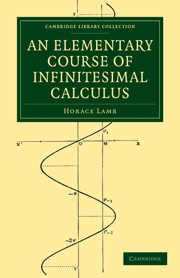Book contents
- Frontmatter
- PREFACE
- Contents
- CHAPTER I CONTINUITY
- CHAPTER II DERIVED FUNCTIONS
- CHAPTER III THE EXPONENTIAL AND LOGARITHMIC FUNCTIONS
- CHAPTER IV APPLICATIONS OF THE DERIVED FUNCTION
- CHAPTER V DERIVATIVES OF HIGHER ORDERS
- CHAPTER VI INTEGRATION
- CHAPTER VII DEFINITE INTEGRALS
- CHAPTER VIII GEOMETRICAL APPLICATIONS
- CHAPTER IX SPECIAL CURVES
- CHAPTER X CURVATURE
- CHAPTER XI DIFFERENTIAL EQUATIONS OF THE FIRST ORDER
- CHAPTER XII DIFFERENTIAL EQUATIONS OF THE SECOND ORDER
- CHAPTER XIII LINEAR EQUATIONS WITH CONSTANT COEFFICIENTS
- CHAPTER XIV DIFFERENTIATION AND INTEGRATION OF POWER-SERIES
- CHAPTER XV TAYLOR'S THEOREM
- CHAPTER XVI FUNCTIONS OF SEVERAL INDEPENDENT VARIABLES
- APPENDIX: NUMERICAL TABLES
- INDEX
CHAPTER VIII - GEOMETRICAL APPLICATIONS
Published online by Cambridge University Press: 07 September 2010
- Frontmatter
- PREFACE
- Contents
- CHAPTER I CONTINUITY
- CHAPTER II DERIVED FUNCTIONS
- CHAPTER III THE EXPONENTIAL AND LOGARITHMIC FUNCTIONS
- CHAPTER IV APPLICATIONS OF THE DERIVED FUNCTION
- CHAPTER V DERIVATIVES OF HIGHER ORDERS
- CHAPTER VI INTEGRATION
- CHAPTER VII DEFINITE INTEGRALS
- CHAPTER VIII GEOMETRICAL APPLICATIONS
- CHAPTER IX SPECIAL CURVES
- CHAPTER X CURVATURE
- CHAPTER XI DIFFERENTIAL EQUATIONS OF THE FIRST ORDER
- CHAPTER XII DIFFERENTIAL EQUATIONS OF THE SECOND ORDER
- CHAPTER XIII LINEAR EQUATIONS WITH CONSTANT COEFFICIENTS
- CHAPTER XIV DIFFERENTIATION AND INTEGRATION OF POWER-SERIES
- CHAPTER XV TAYLOR'S THEOREM
- CHAPTER XVI FUNCTIONS OF SEVERAL INDEPENDENT VARIABLES
- APPENDIX: NUMERICAL TABLES
- INDEX
Summary
Definition of an Area.
In Euclid's Elements a system of propositions is developed by means of which we are able to give a precise meaning to the term ‘area,’ as applied to any figure bounded wholly by straight lines. In particular it is shewn that a rectangle can be constructed equal to the given figure, and having any given base, say the (arbitrarily chosen) unit of length. The ‘area’ of the figure in question is then measured by the ratio of this rectangle to the square on the unit length.
This process obviously does not apply to a figure bounded, in whole or in part, by curved lines, and we require therefore a definition of what is to be understood by the ‘area’ in such a case. To supply this, we imagine two rectilinear figures to be constructed, one including, and the other included by, the given curved figure. There is an upper limit to the area of the inscribed figure, and a lower limit to that of the circumscribed figure, and these limits can be proved to be identical. The common limiting value is adopted, by definition, as the measure of the ‘area’ of the given curvilinear figure.
Thus, in the case of a circle, if, in Fig. 17, p. 31, PQ be the side of an inscribed polygon, the area of the polygon will be ½ ∑ (ON. PQ). Now ON is less than the radius, and ∑ (PQ) is less than the perimeter, of the circle.
Information
- Type
- Chapter
- Information
- An Elementary Course of Infinitesimal Calculus , pp. 232 - 283Publisher: Cambridge University PressPrint publication year: 2009First published in: 1897
